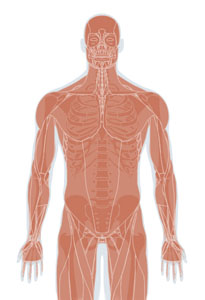 The skeleton (which includes bones, ligaments, tendons, and cartilage) and muscles that are attached to it make up the musculoskeletal system. It gives the body its basic structure, posture, and the ability to move. In addition to the basic structural role , the larger bones in the body contain bone marrow, where blood cells are formed. Also, all bones are major storage sites for calcium and phosphorus. Muscles contract to help operate the respiratory system and maintain body temperature.
The skeleton (which includes bones, ligaments, tendons, and cartilage) and muscles that are attached to it make up the musculoskeletal system. It gives the body its basic structure, posture, and the ability to move. In addition to the basic structural role , the larger bones in the body contain bone marrow, where blood cells are formed. Also, all bones are major storage sites for calcium and phosphorus. Muscles contract to help operate the respiratory system and maintain body temperature.
Click on a substance to go to the health effects chapter in the toxicological profile. Then, search on any target organ system to find the health effects information on that system.